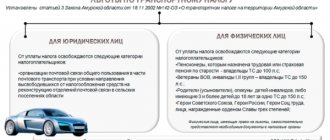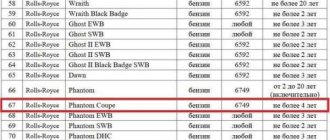Every citizen of the Russian Federation or organization that owns a car is a tax payer. It does not matter whether such a vehicle is used for its intended purpose, whether it is in good working order, how old it is or what its power is. If the car is registered, payment of tax is mandatory. But more recently, important changes have appeared in the country’s legislation. What will the transport tax be in 2018-2019? What exactly has changed? What are the rates in the regions of the Russian Federation? All this is discussed in detail in our publication.
The essence of the tax and who pays it
Transport tax is a mandatory payment to the state, as it is approved by the federal legislation of our country. In this regard, citizens who own transport facilities must make contributions to the state. budget.
But, despite the fact that the law is federal, its compliance is controlled by regional authorities. They are the ones who set tax rates and benefits.
In 2021, owners of the following transport facilities must pay tax:
- Passenger cars;
- Trucks;
- Snowmobiles;
- Helicopters;
- Motor scooters;
- Motor boats and yachts;
- Buses of various sizes;
- Transport objects on pneumatic or caterpillar tracks.
How are the rules for calculating tax established?
The 2021 transport tax, as for previous periods, is calculated based on the following rules:
- contained in the Tax Code of the Russian Federation (Chapter 28);
- introduced by the laws of the region (Article 356 of the Tax Code of the Russian Federation).
The Tax Code of the Russian Federation for transport tax for 2021 establishes the principles for determining:
- the circle of taxpayers and the list of persons not included in their number (Article 357);
- types of transport subject to tax and objects not considered taxable (Article 358);
- what should be considered the tax base for each type of transport (Article 359);
- duration of tax and reporting periods (Article 360);
- the values of tax rates considered basic (Article 361);
- benefits introduced at the federal level (Article 361.1);
- rules for calculating tax and advances on it (Article 362);
- the procedure for making tax payments (Article 363);
- reporting rules (Article 364).
Regions may introduce the following regarding transport tax in 2021:
- own (additional to that specified in the Tax Code of the Russian Federation) list of benefits for it;
- their values of tax rates, focusing on their basic values and restrictions established by the Tax Code of the Russian Federation;
- your tax payment procedure (with or without advance payments);
- your deadlines for payment.
For information on how tax payment rules are established in the region, read the article “Advance payments for transport tax.”
The result of applying all the applicable tax rules in each region is that some of these rules turn out to be strictly defined and valid for the entire territory of the Russian Federation, while others may differ significantly for different regions. The latter gives the transport tax individual features that may be characteristic of one single region.
Changes 2021
Changes in transport tax 2021 can be represented by three points:
- The declaration form was slightly changed - five new lines were added to it.
- The size of the increasing coefficient for expensive cars has been reduced.
- The procedure for providing benefits to citizens has been simplified.
We reviewed all the changes that have occurred in more detail in the article Transport Tax (2018): changes.
Does it make sense to use a tax calculator?
On many websites you can find a calculator that allows you to calculate the amount of transport tax. Does it make sense to use such a calculator to calculate transport tax - 2021?
Of course, such a calculator gives some idea of the amount obtained as a result of calculations on it. However, this value may turn out to be very, very approximate, since the calculator available for the Russian Federation as a whole cannot always take into account the calculation features inherent in a particular region. In addition, it is always possible for non-standard situations not provided for by law to arise.
For examples of such situations, see the materials:
- “Officials told us when there is no need to pay transport tax”;
- “The benefit for heavy trucks will disappear if it is not the owner who pays to Platon”;
- “The Federal Tax Service has changed its opinion on paying transport tax on expensive cars.”
Transport tax calculation
For individuals and legal entities, tax on transport facilities is calculated differently:
- Citizens do not calculate taxes on their own; tax officials do this for them. They send citizens notifications about the need to pay tax by Russian post.
- Organizations have to calculate the tax amounts to be paid independently. In addition, their responsibilities include preparing the appropriate declaration and recording in accounting the accrual and payment of tax and advance payments on it.
Transport tax when using the Platon system
From 01/01/2019, the benefit established by law dated 07/03/2016 No. 249-FZ, which provides for a reduction in transport tax by the amount of payment for road damage caused by heavy trucks to federal roads, ceased to apply. Deductions were provided for tax periods 2016-2018. Now the preference has ceased to apply.
Transport tax is a regional tax. When introducing it into effect in the territory of their region, legislative (representative) bodies of a constituent entity of the Russian Federation can establish differentiated tax rates for each category of vehicles, as well as taking into account the number of years that have passed since the year of production of vehicles and (or) their environmental class. Additional tax benefits may also be provided to owners of heavy trucks.
Another change in the procedure for calculating and paying tax is related to the need for owners of heavy trucks registered in the Platon system not only to calculate, but also to pay advance payments for transport tax, if the region provides for the payment of advance payments for it. In Moscow, according to Part 1 of Art. 3 of the Law of Moscow dated July 9, 2008 No. 33, there is no such obligation. The innovation is caused by the termination of the provisions of the already mentioned law of July 3, 2016 No. 249-FZ. It was allowed to calculate but not pay tax advances until 01/01/2019.
Tax return
A transport tax declaration is a reporting document that must be generated and submitted to the tax office by legal entities and private businessmen who own transport facilities recognized as taxable objects. Individuals do not need to prepare a declaration on their own; the tax authorities do it for them.
Since this year, the declaration form has been slightly changed:
- A field for affixing a company seal has been added.
- The following lines have been added:
- 070 – date of registration of the vehicle with the traffic police;
- 080 – date of deregistration of the transport facility with the traffic police;
- 130 – year of manufacture of the vehicle;
- 280 – code value of the deduction according to the Platon system;
- 290 – the amount of deduction according to the Platon system.
We discussed the declaration in more detail in the article Declaration of transport tax. Also, in this article you can find the current transport tax declaration form, rules and a sample for filling it out .
What form should I use to submit a transport tax return for 2018?
For the period of 2021, the declaration must be submitted in accordance with the form, format and procedure for filling out, approved by Order of the Federal Tax Service of the Russian Federation dated December 5, 2016 No. ММВ-7-21/ [email protected]
For the 2021 tax period, a new tax return form has already been established. The corresponding Order of the Federal Tax Service of the Russian Federation dated November 26, 2018 No. ММВ-7-21/ [email protected] comes into force on February 20, 2019.
The need to update the declaration is due to the termination, as of January 1, 2019, of the provision allowing the deduction of fees for damage to federal roads caused by heavy trucks from the amount of transport tax. In this regard, the procedure for filling out the document has also changed.
There are few other changes:
- barcodes for types of vehicles have been updated;
- benefits and deductions have been clarified;
- instead of three different codes intended for buses, one common one will be introduced.
The new declaration must be applied starting with reporting for 2021, that is, it will be needed already in 2021 - by February 1. Naturally, if transport tax reporting is not abolished altogether, a bill on this has already been considered in the State Duma.
Control ratios with which you can check the correctness of filling out reports for 2021 are given in the letter of the Federal Tax Service of the Russian Federation dated 03.03.2017 No. BS-4-21 / [email protected]
Deadlines for submitting the declaration
In 2021, the deadline for submitting the transport tax return has not been changed. As before, legal entities and private businessmen must provide it to the tax authorities before the first of February of the year following the reporting year. If the first of February falls on a weekend or holiday, the deadline for submission is moved to the next working day.
In 2021, the deadline for submitting the declaration remains the first of February, since this date falls on Thursday, which is not a holiday.
Failure to submit a transport tax return on time exposes the payer to tax and administrative liability:
- For each month of delay, you will have to pay a fine of 5% of the unpaid tax. At the same time, the amount of the fine cannot be less than 1000 rubles and more than 30% of the amount of unpaid tax.
- Failure to submit a declaration, if the tax is paid on time, will result in a fine of 1,000 rubles.
- If you are more than ten days late in submitting your declaration, your current account may be blocked.
- A personal fine in the amount of 300 to 500 rubles may be imposed on the head of the company.
We discussed this topic in more detail in the article Transport declaration: deadlines for submission.
Specifics of calculating transport tax, nuances
Tax payers are considered to be vehicle owners, individuals. the person to whom the vehicle is registered. The tax is paid by the owner of the vehicle; the previously existing rule, when the tax fee could be assigned to the person who owns the object by proxy, has been cancelled.
As already mentioned, the tax is paid to the budget of the region where the owner is registered (at his place of registration), or at the location of the organization (and its separate divisions).
Owners of personal vehicles, as well as private entrepreneurs, pay tax without making independent calculations. The tax regulator does this for them. There is no need to inform the Federal Tax Service about the presence (absence) of taxable objects. Phys. individuals and individual entrepreneurs are exempt from declaring transport tax (as well as from submitting other tax reports). The only obligation of a private owner for movable property tax is to promptly pay the accrued tax before December 1, based on the requirements of the tax service.
The scheme of interdepartmental interaction when registering or deregistering a vehicle looks like this:
- after registering the vehicle with the traffic police or another department (depending on the type of transport);
- within 10 days, information about the object is received by the Federal Tax Service at the place of registration of the taxpayer, this is done within the framework of electronic document management;
- The tax service must also issue or send remotely to the enterprise (individual) a notice of registration (deregistration) of movable property within 10 working days. The notification may appear in the taxpayer’s personal account on the portal of the Federal Tax Service of the Russian Federation, delivered by mail or issued at the inspectorate. Standard forms of notification: No. 1–3-Accounting (No.-3-Accounting) - about registration, and No. 1-5-Accounting (No. 2-4-Accounting) - about deregistration;
- in addition, annually before February 15, the authorities that register vehicles must submit to the Federal Tax Service the information necessary for calculating the tax as of January 1.
At the same time, all vehicle owners are recommended to check their personal account on the government services portal or the Internet resource of the Federal Tax Service of the Russian Federation at the end of the reporting period. If in the first ten days of November of the current year a requirement to pay transport tax did not appear in the taxpayer’s personal account (or the notification did not arrive by mail), this means that the Federal Tax Service does not have data on the availability of movable property. It follows from this that the owner is obliged to independently notify the tax authorities about the property. If a citizen evades reporting information about his property, he faces a fine of 20% of the tax amount (clause 3 of Article 129.1 of the Tax Code of the Russian Federation).
This process is the same for both individuals and organizations.
But if physical Since individuals are only burdened with paying the transport tax, enterprises that have vehicles on their balance sheet must independently calculate the amount of tax and advance payments.
To calculate the transport tax payment for transfer to the regional budget at the end of the reporting period, you need to multiply the tax base and the rate, which is calculated individually for each vehicle.
Generally accepted transport tax rates are determined depending on:
- engine power - for buses, cars and motor vehicles, as well as snowmobiles, snowmobiles, boats, jet skis, yachts, tractors, other tracked vehicles and aircraft;
- year of manufacture of the vehicle - in some cases, different coefficients are set; the older the car, the lower the multiplier;
- environmental class - for example, for cars with electric motors;
- engine thrust - for jet aircraft;
- gross tonnage of the vehicle - for example, for towed barges;
- registered ton or vehicle unit - for watercraft and aircraft without engines.
If regions take the indicator of the year of manufacture when calculating tax rates, you need to understand that the age of the vehicle begins its countdown from January 1 of the year when this vehicle left the factory assembly line.
Basically, the tax is calculated based on the power or engine capacity of the movable vehicle. At the same time, legislators included serious coefficients when calculating tariffs: the more horsepower in the engine, the higher the tariff will be. For example, the difference in fees between a small car and an SUV can be up to 20 times.
The more expensive and “younger” the car, the higher the coefficient and tax rate
When calculating the cost of tax on a passenger car, the cost of the car may also affect the tariff rate. The Ministry of Industry and Trade of the Russian Federation regularly publishes a list of expensive cars, the cost of which today is fixed at a minimum of three million rubles. In accordance with the second paragraph of Art. 362 of the Tax Code of the Russian Federation, starting from January 2014, the tax accrual for cars with an average market price of over 3 million rubles is calculated taking into account increasing factors that are charged depending on the year of manufacture of the car.
In 2021, this list included about 800 car models of leading brands, on average up to 3 years old. But there are expensive versions, the increased tariff for which applies up to 20 years after their release.
The list of expensive cars, the tax on which is subject to an increased tariff, is published on the Mipromtorg website every year before March 1; you can check the data on the VIP list of cars using the link.
Tax legislation establishes increasing coefficients for cars, depending on the age of the car.
Table: coefficients for expensive cars
| Mid-priced passenger cars | Year of manufacture of passenger cars | |||
| up to 3 years | no more than 5 years | no more than 10 years | no more than 20 years | |
| from 3 million to 5 million rubles inclusive | 1,1 | — | — | — |
| from 5 million to 10 million rubles inclusive | — | 2 | — | — |
| from 10 million to 15 million rubles inclusive | — | — | 3 | — |
| from 15 million rubles | — | — | — | 3 |
In almost all regions of the country, tax rates are regulated by the executive branch, and they can change every tax period (year). Therefore, tax payments for transport in 2021 vary significantly, it all depends on the region where the vehicle is registered.
It is not clear by what logic (or rather, anti-logic) the TN rate for the most budget low-power car in the Perm Territory is 5 times higher than the rate in Sevastopol (25 rubles versus 5 rubles). And if the deviation regarding Crimea, as a territory of economic development, can somehow be justified, then why in Moscow the rate is 2 times lower than in Perm is a question. It is hardly appropriate to compare the average standard of living or the number of cars on the roads here. The main argument and justification here is only one - the transport tax is one of the main sources of filling the regional budget, so legislators are obviously trying to bring the local budget out of deficit.
If a vehicle is deregistered during a calendar year, the tax is calculated as follows:
- the number of full months when the vehicle was registered as the property of the taxpayer is divided by 12 months. This coefficient is taken into account when calculating the fee;
- Moreover, if the vehicle was registered before the 15th day inclusive, this month is not taken into account in the tax period;
- if after - it is considered as a full month of vehicle ownership (clause 3 of Article No. 362 of the Tax Code of the Russian Federation);
- The situation with transit license plates for cars is interpreted unambiguously by tax authorities - as long as the vehicle has a “transit” registration plate, it is not subject to tax.
And the last point when determining payments: if a vehicle is registered and deregistered on the same day, transport tax is not paid.
Examples of calculations
Let's consider the standard tariffs established by the Tax Code of the Russian Federation, as well as regional rates:
- For a car with a capacity of 140 “horses”, which was owned by the owner for a full tax year, in 2021, at the generally accepted rate, you will have to pay to the treasury - transport tax: 140 hp. *3.5 rub. (bet) = 490 rubles.
- If the owner sold the same car and it was deregistered on October 20 - transport tax: (10 months of ownership / 12 months: coefficient) *140 hp. *3.5 rub. (rate) = 408 rubles 33 kopecks, since October is considered according to the “rule of 15” as a full month.
- If the same car is registered, for example, in the Perm region, the transport tax will be: 140 hp. * 30 rub. (tariff adopted in the region for 2021) = 4,200 rubles.
- And if this is, for example, a BMW 6 Series, registered in Moscow, which has been owned by the owner for more than a year, the approximate calculation of the fuel charge in 2018 will look like this: 300 hp. * 150 rub. (Moscow tariff) * 1.1 (coefficient for cars worth three million or more, up to three years old) = 49,500 rubles.
Transport tax rates can vary significantly - it all depends on the regional authorities
Table: standard rates for transport tax (Article 361 of the Tax Code of the Russian Federation)
| Name of taxable object | Tax rate (in rubles) | Approximate tax amount, year |
| Passenger cars with engine power (per horsepower): | ||
| up to 100 hp (up to 73.55 kW) inclusive | 2,5 | 250 ₽ |
| over 100 hp up to 150 hp inclusive | 3,5 | 525 ₽ |
| over 150 hp up to 200 hp inclusive | 5 | 1 000 ₽ |
| over 200 hp up to 250 hp inclusive | 7,5 | 1 875 ₽ |
| over 250 hp | 15 | 4 500 ₽ |
| Motorcycles and scooters with engine power (per horsepower): | ||
| up to 20 hp inclusive | 1 | 20 ₽ |
| over 20 hp up to 35 hp inclusive | 2 | 70 ₽ |
| over 35 hp | 5 | 200 ₽ |
| Buses with engine power (per horsepower): | ||
| up to 200 hp inclusive | 5 | 1 000 ₽ |
| over 200 hp | 10 | 2 500 ₽ |
| Trucks with engine power (per horsepower): | ||
| up to 100 hp inclusive | 2,5 | 250 ₽ |
| over 100 hp up to 150 hp inclusive | 4 | 600 ₽ |
| over 150 hp up to 200 hp inclusive | 5 | 1 000 ₽ |
| over 200 hp up to 250 hp inclusive | 6,5 | 1 625 ₽ |
| over 250 hp | 8,5 | 2 550 ₽ |
| Snowmobiles, motor sleighs with engine power (per horsepower): | ||
| up to 50 hp inclusive | 2,5 | 125 ₽ |
| over 50 hp | 5 | 400 ₽ |
| Boats, motor boats and other water vehicles with engine power (per horsepower): | ||
| up to 100 hp inclusive | 10 | 1 000 ₽ |
| over 100 hp | 20 | 3 000 ₽ |
| Jet skis with engine power (per horsepower): | ||
| up to 100 hp inclusive | 25 | 2 500 ₽ |
| over 100 hp | 50 | 7 500 ₽ |
More information about transport tax rates can be found here.
Tax benefits for car owners
Transport tax preferences are regulated by Article 361.1 of the Tax Code of the Russian Federation, which states that:
- Owners of vehicles weighing more than 12 tons that are registered in the all-Russian system “Platon” are exempt from tax if payments for this vehicle paid during the reporting tax period exceeded (or are equal to) the amount of the tax fee;
- if the amount of tax exceeds the amount of “Plato”, these costs are deducted from the tax fee;
- To receive deductions, the vehicle owner must:
- fill out an application in the form approved by Appendix No. 1 to the order of the Federal Tax Service of the Russian Federation dated November 14, 2017 No. ММВ-7–21/ [email protected] (you can read the form and download it here);
- provide payment documents confirming participation in the Platon program.
It is worth considering that private businesses whose transport takes part in the Platon program also have the right to tax benefits. In this case, the individual entrepreneur does not need to fill out a declaration, as legal entities are required to do, he simply must fill out an application. The Federal Tax Service will calculate the tax based on the confirmed benefit.
Instructions: how to clarify the tax rate
The easiest way to check the current exact tariffs for transport tax is on the tax service portal; this service will also tell you what benefits are provided for by regional legislation in a particular year. The link to the tax website, which, by the way, can be used to clarify the rates for all property taxes, is here.
Brief instructions on how to use the tax service are simple:
- from the main page of the portal of the Federal Tax Service of the Russian Federation, go to the “Electronic Services” page, select the “Reference information on property taxes” section;
- on the page select: type of tax - transport, and tax period - year for which you need to generate a report;
- Select your subject of the Russian Federation in the drop-down list and start the search;
- by clicking “more details” in the tab, detailed information will appear on the deadlines for payment of transport tax for individuals, individual entrepreneurs, as well as legal entities (for example, the tax payment deadline for legal entities in Moscow is no later than 02/05/2018, advance payments do not need to be transferred to the budget );
- on the same page you can clarify transport rates depending on the vehicle’s capacity, as well as benefits, deductions, regional and federal benefits for owners.
Photo gallery: online reference information on property rates and benefits
On the reference information page on property taxes of the portal of the Federal Tax Service of the Russian Federation, select the type of tax and period
Select a subject of the Russian Federation from the drop-down list
To find out detailed information on tax in a specific region, go further
Let's look at the rates
Checking federal deductions
We clarify federal and regional benefits
Tax rates
Transport tax rates are set by the authorities of a particular region. In this regard, in some regions they may be higher, and in others lower.
However, there are basic rates that are established in the Tax Code of the Russian Federation, in Article 361. Depending on the capacity of the transport facility, they may be different. The more power, the higher the rate. The rate is set for one horsepower in rubles.
Regional authorities have the right to increase or decrease these base rates, but not more than ten times. However, there is an exception. The base rate for cars with a capacity of less than 150 horsepower cannot be reduced.
In addition, regional legislation may establish differentiated rates, depending on the year of manufacture of the transport facility and its environmental class.
We discussed transport tax rates in 2021 by region in more detail in the article Transport tax rate.
Calculation of transport tax for legal entities
The procedure for calculating TN and advances is defined in stat. 362 NK. For the calculation, indicators of the tax base of the transport facility and the current rate in the region are taken. Additionally, the values of the increasing coefficient and the coefficient of actual vehicle ownership for the tax period are taken into account. The general calculation formula is as follows:
TN = NB x St in % x PovK x FactK, where:
TN - transport tax,
NB – facility power in liters. With. (for auto),
St. in % - the rate for the object in %, valid in the region,
PovK - increasing coefficient for premium cars according to clause 2 of the stat. 362,
FactK – coefficient of actual vehicle ownership for the tax period. Calculated according to the rules of clause 3 of stat. 362.
If an enterprise has several vehicles, the tax is determined separately for each. The results of the calculations are presented to the Federal Tax Service at the place of registration of the car owner in the form of a declaration for the tax period, that is, the calendar year.
Tax calculator for Moscow
To calculate the amount of tax payable, we can use the 2021 transport tax calculator for Moscow.
To use it, proceed in the following order:
- Enter the corresponding indicators into the columns of the calculator:
- Type of transport facility;
- Cost, engine power and year of production;
- Share in ownership, as a percentage (by default, the calculator is 100%, since in most cases transport facilities have only one owner);
- The period during which you own the transport objects in the current year (in complete months).
- After all the required fields have been filled in, click the “calculate” button. The calculator will show the amount of tax payable.
- If you own more than two transport facilities, the tax must be calculated separately for each of them.
When will the transport tax be abolished in Russia?
Starting from 2018-2019, individuals and individual entrepreneurs do not have to pay transport fees to the state for periods before January 1, 2015. The corresponding law was signed by the president of the country in December 2021. At the same time, all tax debts of entrepreneurs and citizens will be written off automatically. This type of write-off includes debts that arose before January 1, 2015. If you were charged a penalty for non-payment, this will also be written off automatically.
Please pay special attention: you do not need to submit any documents to the tax office. The tax authorities themselves will write off everything and cover all debts. There is also no need to attend the inspection in person. Even if you have some debts, for example, for 2014 and penalties for non-payment, then in 2018-2019 this debt will be written off automatically - both tax and penalties.
Tax benefits
For some categories of citizens, tax breaks are provided for transport tax.
Thus, transport tax benefits for disabled people may provide for a complete exemption from payment or a discount. In order to take advantage of the benefit, two conditions must be met simultaneously:
- The car must be a passenger car, purchased at the expense of the guardianship authorities;
- A citizen must have a disability certificate, which can confirm the right to receive benefits.
Transport tax benefits for pensioners are not provided for pensioners in all regions. In some regions, no benefits are provided at all, and in some, pensioners are completely exempt from paying taxes.
The benefit is not assigned automatically; to receive it you will have to submit the following package of documents:
- Application for provision;
- Passport;
- SNILS and TIN;
- Documentation for the transport facility;
- Documentation confirming the right to receive benefits.
We discussed transport tax benefits in more detail in the article Transport tax: benefits for the disabled, pensioners and more.
Parameters that determine the tax calculation process
The basis of the transport tax calculation procedure is a standard operation in which the tax base is multiplied by the rate. The features here will be manifested in the following:
- the tax base may vary depending on the type of transport and be expressed: in power - in horsepower (for vehicles with an engine, except for an air jet);
- thrust of a jet engine (engines) - in kilograms of force (for air jet transport);
- gross tonnage - in tons (for non-propelled water transport);
- the very fact of having a vehicle (for other transport), i.e. each unit of such transport becomes the base;
Tax calculation is carried out by the taxpayer himself, if he is a legal entity, or by the Federal Tax Service, if the tax payer is an individual (including individual entrepreneur).
Taking these features into account, the legal entity will also calculate tax advances if the region has not waived reporting periods and, accordingly, the payment of advances upon their completion. The amount of the advance for the next quarter will be ¼ of the tax amount calculated according to the above rules. The amounts of advances accrued during the year will be taken into account when determining the final tax payment amount. Owners of heavy trucks are exempt from advance payments.
For formulas for calculating tax and advances for it, see the material “How to calculate transport tax for the year?”
Increasing factor
In 2014, increasing coefficients were introduced for expensive cars. They are still used today. In 2021 their values are as follows:
| Car cost | Car age | Odds size |
| From 3 to 5 million rubles | Up to 3 years | 1,1 |
| From 5 to 10 million rubles | Up to 5 years | 2 |
| From 10 to 15 million rubles | Up to 10 years | 3 |
| More than 15 million rubles | Up to 20 years | 3 |
Until the beginning of 2021, cars costing from 3 to 5 million rubles were differentiated by age. There were three different coefficients:
- Age up to one year – 1.5;
- Age from one to two years – 1.3;
- Age from two to three years – 1.1.
Now a single coefficient of 1.1 is applied, regardless of the age of the car.
Has the transport tax really been abolished?
The transport tax has become so familiar to citizens of the Russian Federation that it was difficult for many to imagine its abolition. Nevertheless, this happened - such information quite recently literally shook up the Internet. The president of the country allegedly signed the corresponding law. As a result, the new rules were approved by society and received only positive feedback. In essence, fuel prices were increased. As a result, gasoline became more expensive.
In practice, this would mean that those drivers who actively use vehicles would pay much more than those who drive very little or, for certain reasons, do not use their car at all. Or, in other words, if you are the happy owner of ten cars, then you won’t pay too much for any of them. After all, the payment for road transport will be calculated from the increased excise tax on gasoline. The rule is simple: those who drive more pay more.
Unfortunately, this turned out to be untrue. This transformed news came from several sources. First of all, Dmitry Medvedev’s comment that the transport tax has been abolished for electric vehicles, and the regions still do not take advantage of this at all. As well as the new law of 2018-2019 on amnesty for taxes unpaid before 2015.
Tax payment deadlines
Depending on whether the owner of the transport facility is an individual or a legal entity, the deadlines for paying transport tax 2021 will vary.
For individuals, the deadline for payment is the first of December of the year following the reporting year (tax for 2017 is paid in 2021).
In 2021, the deadline for payment is the third of December, since the first day falls on a Saturday, a day off. In accordance with the postponement rule, the payment deadline is postponed to the next business day.
For legal entities and private businessmen, specific payment deadlines are set by the regional authorities. In most regions, legal entities are required to pay tax advances, that is, at the end of each quarter they must pay certain amounts, and the balance must be paid by the first of February of the year following the reporting year.
Each region sets the specific terms for payment of advances independently, but in most cases the following scheme is used:
- 1st quarter – April;
- 2nd quarter – July;
- 3rd quarter – October;
- Tax for the year – until the first of February next year.
How is transport tax paid?
For a long time, it was possible to pay taxes only by following the following scheme:
- Receive a receipt by mail or request it yourself at the tax office operating in your city.
- Come to the bank, stand in line and deposit the payment into the tax service account.
Since the bank's opening hours coincide with the working hours of most institutions, many people were forced to take time off or waste their legal day off. However, today the situation has changed. Thanks to the gradual informatization and digitalization of most services, today you can also pay transport tax:
1. Through the unified state portal “State Services”.
2. On the official website of the Federal Tax Service.
3. On the Sberbank Online website or through the mobile application of the same name.
In addition, there are other resources that offer to pay transport tax online. However, they all only perform intermediary functions in order to attract a larger audience. And the protection of personal data on such sites is not guaranteed.
Liability for non-payment
If physical or a legal entity fails to pay the transport tax on time, this will allow the tax service to:
- Conduct a tax audit;
- Accrue penalties;
- To fine;
- Place a temporary freeze on the payer’s accounts;
- Seize property and money;
- To collect the amount of tax payable from the salary of an unscrupulous payer;
- Prohibit leaving Russian territory.
If the tax was unpaid or not paid in full, the payer will face a fine in the amount of 20% of the underpaid or completely unpaid tax amount. If the tax inspectorate reveals malicious actions, the fine will increase to 40%. This responsibility applies to legal entities and private businessmen.
For individuals, a slightly different liability is provided: penalties in the amount of 1/300 of the refinancing rate are charged on the unpaid amount for each late payment day.
What happens if you don't pay?
Refusal to pay transport tax is considered unlawful and entails first administrative and then criminal liability. If you have not made the payment on time, from the first day of delay (for individuals - December 2), the system begins to accrue penalties according to the formula:
Amount of penalty = (Amount of overdue * number of days until repayment * current key rate of the Central Bank of the Russian Federation)/30000.
If the vehicle was stolen after the debt had arisen, the number of “days until repayment” can be reduced by as many days as the car was in the thief’s possession.
In addition to the penalty, the tax office has the right to charge the debtor a fine, the amount of which is:
- 20% of the debt amount – if the delay in payments occurred for independent reasons.
- 40% of the debt amount - if the citizen acted intentionally and falsified the data in the declaration.
Termination of tax collection
The obligation to pay transport tax terminates upon the occurrence of the following circumstances:
- Payment of tax in full;
- Death of the owner of the transport facility;
- The occurrence of other circumstances listed in Article 44 of the Tax Code of the Russian Federation;
- Theft of a vehicle, officially registered with the traffic police;
- The emergence of the right to use tax benefits.
In other cases, the payer is exempt from paying tax only when he deregisters the transport facility with the traffic police.
In what cases is it not necessary to pay transport tax?
There is no need to pay transport tax if the vehicle is registered and deregistered:
- in the period from the 1st to the 15th of the month;
- from the 16th to the 30th of the month;
- when registering after the 15th of one month and deregistering before the 15th of the next month;
- one day.
Such clarifications are given in the letter of the Federal Tax Service of the Russian Federation dated June 19, 2017 No. BS-4-21/ [email protected]
In addition, no tax is paid in case of car theft (letter of the Ministry of Finance of the Russian Federation dated October 3, 2017 No. 03-05-06-04/64192).
The agency explained which documents can exempt the owner of a car from paying transport tax if it is stolen.
According to paragraphs. 7 paragraph 2 art. 358 of the Tax Code of the Russian Federation, a vehicle will not be taxed provided that supporting documents from law enforcement agencies are provided to the Federal Tax Service. They may be:
- certificate of theft;
- resolution to initiate a criminal case.
In addition, the department reminded that a lost car can be deregistered with the State Traffic Safety Inspectorate (Order of the Ministry of Internal Affairs of the Russian Federation dated November 24, 2008 No. 1001). To do this, the owner will need to send an application to the appropriate traffic police department.
Let us note that Art. 85 of the Tax Code of the Russian Federation obliges the traffic police to independently, without the participation of the owner of the vehicle, report to the Federal Tax Service the fact of deregistration of a stolen car. This is done within 10 days. If a stolen car is found, it can be registered again.









